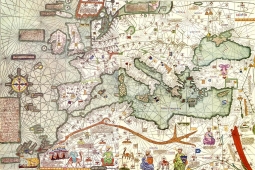The Spread of Disease along the Silk Roads: Smallpox
This article is the second in a series on the spread of disease along the Silk Roads which examines the ways in which people have historically responded to illness and explores how we might approach newly arising challenges today. It uses the Silk Roads as an instructive example of the benefits of an interconnected world built on collaboration and timely and reliable knowledge sharing. This article details the spread of smallpox along the Silk Roads and the transmission of novel public health measures to combat it, including variolation and, later, vaccines.
Wherever people, animals and goods have moved and brought enriching effects, undesirable phenomena such as disease have also been transmitted on a broad scale. Historically, trade and movement have inevitably played a major role in the spread of infectious disease. In addition to diseases caused by bacteria, such as Plague, many viruses have been transmitted via movement along the Silk Roads. One notable example of a viral disease which has been prevalent throughout much of human history is smallpox. However, just as the disease itself travelled the Silk Roads, so too did a number of public health measures designed to combat it, including an early precursor to vaccinations, a practice known as “variolation”. Indeed, the first ever vaccines produced were used to protect people from catching smallpox, which, due to large scale international vaccination programmes in the 20th century, has since been successfully eradicated worldwide.
Smallpox is an infectious disease caused by the “Variola” virus characterised by the formation of small sores all over the body. The disease spreads via contact with an infected person or from a contaminated item such as clothing or bedding. Although the exact origins of smallpox are unknown, there is evidence of the disease having been present in Ancient Egypt from as early as the 3rd century BCE. It appears that trade played an early role in spreading smallpox and there is speculation amongst historians that traders from Egypt might have transmitted the disease to the Indian Subcontinent sometime in the 1st millennium BCE. Some of the earliest written descriptions of smallpox date from 4th century CE China and, as trade along the Silk Roads increased in the 6th century CE, the disease spread rapidly to Japan and the Korean Peninsula. Notably, smallpox broke out between 735 – 737 CE in Japan, where it is believed to have killed up to one-third of the population.
By the 7th century CE, as trade and travel along the Silk Roads increased, smallpox became “endemic” (outbreaks regularly reoccurring within a given population) in the Indian Subcontinent. Muslim expansion during this time spread smallpox into Northern Africa, Spain and Portugal. In the 9th century CE, the Persian physician Razi, an early proponent of experimental medicine and chief physician of Baghdad and Rey hospitals in the Abbasid Caliphate, produced one of the most definitive descriptions of smallpox and the first account differentiating it from other similar diseases such as measles and chickenpox. By the 10th century smallpox had spread throughout Anatolia, with another wave of increased activity along the Silk Roads in the 13th century CE causing the disease to become endemic in previously unaffected areas such as Central and Northern Europe. In the 15th century, Portuguese expeditions to the West Coast of Africa and the establishment of new trade routes introduced the disease to further previously unaffected areas.
Despite the fact that the movement of people and goods across vast distances has undoubtedly aided the spread of disease, the medical sciences have been one of the direct beneficiaries of the resulting intercultural exchanges. An excellent example of this is the development and transmission of “variolation”, a practice which was an early precursor to smallpox vaccination. There are early accounts of priests from the Indian Subcontinent travelling the Silk Roads popularising the practice of what they called “tika”, an early effort at inoculation (the introduction of a disease-causing agent in order to produce immunity to a specific disease). This involved taking matter from a smallpox patient’s sores and applying it to a small wound on an uninfected person, the idea being that the uninfected person would develop only a very mild case of the disease and, on recovery, become immune to catching a severe case in the future.
This practice may have developed independently in the Indian Subcontinent or, alternatively, practitioners might have learned it from Muslim physicians, who themselves came into contact with the practice via travel and trade with China. As early as the 1400s, medical healers in China had realized that those who survived smallpox did not catch the illness again and inferred that exposure to the illness protected a person from future instances of it. This observation gave rise to a second important public heath measure which was that those who had contracted the disease and survived were able to treat and care for new patients as they had incurred a natural immunity and were unlikely to become ill a second time. In order to transfer this immunity to new patients, Chinese doctors would grind smallpox scabs into a powder and insert it into a person’s nose with a long silver pipe. If only a very small amount of the virus was ingested that person would have a mild experience of the disease and be immunized for life. Similar practices, of “variolation”, were also documented in Africa in accounts from what is today Sudan. By the 16th century, this practice was a widespread public health measure enacted across many regions of the Silk Roads reaching as far west as Anatolia, having been introduced via descriptions from travellers and merchants.
Throughout history, as we have developed better knowledge of how diseases are transmitted, how they can be treated, and the relevant public health measures that prevent their spread, a major trend for many endemic diseases has been the gradual reduction in their impact over time. In the case of a number of viral diseases, these measures have included the development of vaccinations, which, as in the practice of variolation, have an historic precedent in medicine transmitted along the Silk Roads. In the 18th century, the English physician Edward Jenner built on the idea of variolation and made a major contribution to the development of the modern smallpox vaccine. He observed that those who had contracted cowpox, a similar but milder viral infection, rarely went on to catch smallpox later in life. It is from the disease cowpox, known in Latin as variola vaccina, that we derive the term “vaccine”. Coordinated international vaccination programmes throughout the 20th century led to the eradication of smallpox in 1980, and today outbreaks of the disease no longer occur anywhere in the world. The eradication of smallpox is a testament to the development of the medical sciences over a long period of time, building on and sharing pre-existing medical knowledge and coordinating public health initiatives. A natural precursor to this vaccination dates back many hundreds of years with its origins in the many exchanges in the medical sciences taking place along the Silk Roads.
Related articles

The Spread of Disease along the Silk Roads: Plague
This article explores the spread of plague, known as ‘the Black Death’, across the Silk Roads of the 14th Century CE. It examines ways in which people responded to the disease and looks at how we can respond to newly arising challenges today, utilizing the Silk Roads as an instructive example of the benefits of an interconnected world built on collaboration and timely and reliable knowledge sharing.

The Spread of Disease along the Silk Roads: The Development of Medical Botany and Pharmacology
This article is the third in a series on the spread of disease along the Silk Roads. Its outlines the early development of medical botany and pharmacology during the Middle Ages and identifies the role of the Silk Roads in helping fuel an incredible period of scholarship, particularly within the field of medicine, during the 8th and 9th centuries CE.




